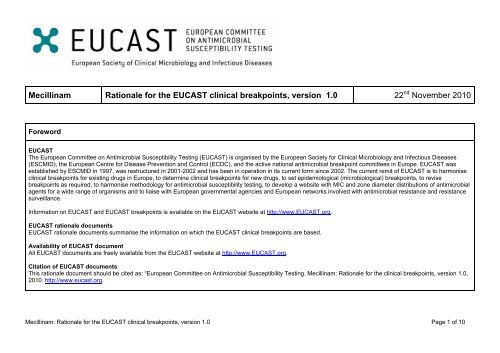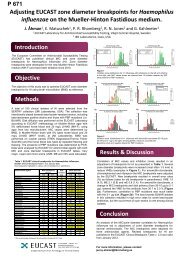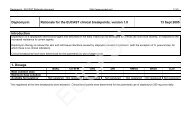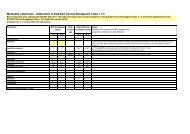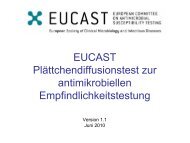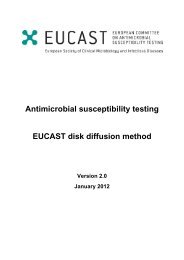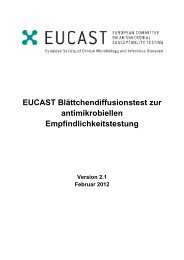Mecillinam - eucast
Mecillinam - eucast
Mecillinam - eucast
You also want an ePaper? Increase the reach of your titles
YUMPU automatically turns print PDFs into web optimized ePapers that Google loves.
<strong>Mecillinam</strong> Rationale for the EUCAST clinical breakpoints, version 1.0 22 nd November 2010ForewordEUCASTThe European Committee on Antimicrobial Susceptibility Testing (EUCAST) is organised by the European Society for Clinical Microbiology and Infectious Diseases(ESCMID), the European Centre for Disease Prevention and Control (ECDC), and the active national antimicrobial breakpoint committees in Europe. EUCAST wasestablished by ESCMID in 1997, was restructured in 2001-2002 and has been in operation in its current form since 2002. The current remit of EUCAST is to harmoniseclinical breakpoints for existing drugs in Europe, to determine clinical breakpoints for new drugs, to set epidemiological (microbiological) breakpoints, to revisebreakpoints as required, to harmonise methodology for antimicrobial susceptibility testing, to develop a website with MIC and zone diameter distributions of antimicrobialagents for a wide range of organisms and to liaise with European governmental agencies and European networks involved with antimicrobial resistance and resistancesurveillance.Information on EUCAST and EUCAST breakpoints is available on the EUCAST website at http://www.EUCAST.org.EUCAST rationale documentsEUCAST rationale documents summarise the information on which the EUCAST clinical breakpoints are based.Availability of EUCAST documentAll EUCAST documents are freely available from the EUCAST website at http://www.EUCAST.org.Citation of EUCAST documentsThis rationale document should be cited as: “European Committee on Antimicrobial Susceptibility Testing. <strong>Mecillinam</strong>: Rationale for the clinical breakpoints, version 1.0,2010. http://www.<strong>eucast</strong>.org.<strong>Mecillinam</strong>: Rationale for the EUCAST clinical breakpoints, version 1.0 Page 1 of 10
Introduction<strong>Mecillinam</strong> is an amidinopenicillin. It is administered orally as pivmecillinam, which is hydrolysed to the active drug, mecillinam in vivo.<strong>Mecillinam</strong> is active against many Gram-negative bacteria but Acinetobacter spp. and Gram-positive bacteria are commonly resistant or activity is poor. Resistance mayarise following permeability changes or due to production of certain beta-lactamases.<strong>Mecillinam</strong> is considered relevant only for therapy of uncomplicated urinary tract infections caused by E. coli, Klebsiella spp. and P. mirabilis. Clinical experience withmecillinam in the treatment of infections caused by bacteria other than E. coli, Klebsiella spp. and P. mirabilis.is very limited.1. DosageBSAC CA-SFM CRG DIN NWGA SRGAMost common dose 200 mg x 3200 mg x 3400 mg x 2- - 200-400 mg x 3 200 mg x 3Maximum dose schedule 400 mg x 4 400 mg x 4 - - 400 mg x 4 400 mg x 3Available formulations Oral Oral - - Oral Oral<strong>Mecillinam</strong>: Rationale for the EUCAST clinical breakpoints, version 1.0 Page 2 of 10
2. MIC distributions and epidemiological cut-off (ECOFF) values (mg/L)0.002 0.004 0.008 0.016 0.032 0.064 0.125 0.25 0.5 1 2 4 8 16 32 64 128 256 512 ECOFFAcinetobacter spp. 0 0 79 9 10 10 53 10 20 9 19 28 56 50 70 77 162 179 0 NDCitrobacter freundii 0 0 1 1 0 1 0 0 0 0 0 1 4 0 3 1 0 0 0 NDCitrobacter koseri 0 0 0 0 0 0 6 2 169 22 17 25 31 20 9 6 37 1 3 NDCitrobacter spp. 0 0 0 17 2 0 29 7 700 225 176 267 373 453 345 436 1697 118 25 NDEnterobacter aerogenes 0 0 0 0 0 0 0 0 3 1 8 0 0 1 0 0 0 1 0 NDEnterobacter cloacae 0 0 0 0 0 0 1 1 12 4 6 1 2 1 0 0 1 1 0 NDEnterobacter spp. 0 0 0 0 0 41 238 275 109 54 56 34 26 3 3 2 1 0 0 1Escherichia coli 0 0 2 3 7 118 215 335 202 160 241 228 183 82 34 23 7 22 8 1Klebsiella pneumoniae 0 0 0 0 0 0 0 0 0 0 1 4 3 11 3 0 0 3 0 NDMorganella morganii 0 0 0 1 0 0 1 6 18 14 6 11 5 10 5 3 5 1 1 NDProteus mirabilis 0 0 0 0 0 0 0 0 0 0 2 0 4 4 0 1 0 0 0 NDProteus vulgaris 0 0 0 0 0 0 0 0 0 0 1 3 10 1 2 0 2 0 0 NDProvidencia spp. 0 0 0 0 0 1 0 0 62 294 777 234 142 142 120 160 135 24 36 8Providencia stuartii 0 0 0 0 0 1 0 1 14 68 370 90 48 22 3 4 3 1 0 8Pseudomonas aeruginosa 0 0 0 0 0 4 0 0 4 121 313 79 80 34 17 18 12 9 43 8Salmonella spp. 0 0 11 24 33 17 2 3 0 3 1 0 2 0 0 0 0 0 0 0.125Serratia liquefaciens 0 0 0 0 0 0 0 0 2 0 0 1 0 1 7 0 18 2 5 NDSerratia marcescens 0 0 0 0 2 0 2 5 43 238 1006 624 297 329 417 327 144 70 53 8Staphylococcus saprophyticus 0 0 0 0 0 0 0 3 25 20 5 5 0 0 0 0 0 0 0 NDStenotrophomonas maltophilia 0 0 0 2 9 15 42 166 669 1582 4020 1560 665 526 663 776 961 146 87 8Yersinia enterocolitica 0 0 0 0 0 0 0 0 1 4 24 4 2 1 2 0 0 0 0 8The table includes MIC distributions available at the time breakpoints were set. They represent combined distributions from multiple sources and time periods. Thedistributions are used to define the epidemiological cut-offs (ECOFF) and give an indication of the MICs for organisms with acquired or mutational resistance mechanisms.They should not be used to infer resistance rates. When there is insufficient evidence no epidemiological cut-off has been determined (ND).<strong>Mecillinam</strong>: Rationale for the EUCAST clinical breakpoints, version 1.0 Page 3 of 10
3. Breakpoints prior 1 to harmonisation (mg/L) S< R>BSAC CA-SFM CRG DIN NWGA SRGA CLSI 2General breakpoint1/8Species specific breakpoints:Enterobacteriaceae 8/8 2/8 2/8 1/8 8/16Pseudomonas spp.Acinetobacter spp.Staphylococcus spp.Streptococcus spp.Alpha haemolytic streptococciStreptococcus pneumoniaeEnterococcus spp.Haemophilus influenzaeMoraxella catarrhalisCorynebacteriaNeisseria meningitidisNeisseria gonorrhoeaePasteurella multocidaAnaerobes, Gram-positiveAnaerobes, Gram-negativeCampylobacter spp.Helicobacter pylori1 20052 CLSI breakpoints converted to EUCAST terminology.<strong>Mecillinam</strong>: Rationale for the EUCAST clinical breakpoints, version 1.0 Page 4 of 10
4. PharmacokineticsDosage (mg) 200 x 1 400 x 1Bioavailability 60-75% 60-75%Cmax (mg/L) 3.5 176-1324 (urine)Cmin (mg/L) 6 hrTotal body clearance (L/g/h)T ½ (h), mean (range) 0.7 - 1 1.79 (urine)AUC24h (mg.h/L)Fraction unbound (%) 90 - 95Volume of distribution (L/kG) 0.2 – 0.4Comments• Pharmacokinetic data are based on a single dose.• Two values are given where references differ. Cells are left empty when data are not readily available.• Oral absorption is c. 75 %, Approximately 60 % is excreted unchanged in urine in the first 6h• No active metabolitesReferences• Kerrn MB et al. Clin Microbiol Infect 2004;10;54-61• Bryskier. Penicillins. In Antimicrobial Agents 2005; pp113-162<strong>Mecillinam</strong>: Rationale for the EUCAST clinical breakpoints, version 1.0 Page 5 of 10
5. PharmacodynamicsEnterobacteriaceae%fT>MIC for stasis : exp 30 – 35%fT>MIC for 2 log drop : exp%fT>MIC from clinical dataComments• Cells are left empty when data are not readily available.• <strong>Mecillinam</strong> is used only for lower urinary tract infections• Urine concentrations are sufficiently high to meet the pharmacodynamic target in strains with MICs of ≤8 mg/L• <strong>Mecillinam</strong> is moderately stable to many Gram-negative beta-lactamases including many extended-spectrum beta-lactamases.No clinical trials have been carried out in patients with infections caused by ESBL-producing E.coli.References • Kerrn M.B. et al, Clin Microbiol Infect 2004;10: 54-61<strong>Mecillinam</strong>: Rationale for the EUCAST clinical breakpoints, version 1.0 Page 6 of 10
6. Monte Carlo simulations and PK/PD BreakpointsNot available.<strong>Mecillinam</strong>: Rationale for the EUCAST clinical breakpoints, version 1.0 Page 7 of 10
7. Clinical data<strong>Mecillinam</strong> has been shown to be well tolerated and give a bacteriological cure rate in uncomplicated urinary tract infection of >85 % with the treatment schedule of 400mg x 2 for 3 days; and similar clinical cure rates to norfloxacin (400 mg x2 for 3 days) when given at a dose of 200 mg x 2 for 7 days.• Nicolle LE et al. J Antimicrob Chemother 2000; 46, Suppl. S1: 35-39<strong>Mecillinam</strong>: Rationale for the EUCAST clinical breakpoints, version 1.0 Page 8 of 10
8. Clinical breakpointsNon-species-relatedbreakpointsThere is insufficient evidence to set non-species-related breakpoints.Species-relatedbreakpointsBreakpoints were based on pharmacokinetic data, microbiological data and clinical experience. Concentrations in urine are high enough toprovide an appropriate fT>MIC in urine.For E. coli, Klebsiella spp. and P. mirabilis breakpoints are S ≤8 mg/L / R >8 mg/L.Species withoutbreakpointsPseudomonas aeruginosa, Acinetobacter spp., Staphylococcus spp., Enterococcus spp., streptococci, Haemophilus influenzae, Moraxellacatarrhalis, Neisseria spp. and anaerobes were considered poor targets or inappropriate for mecillinam therapy and for that reason did notreceive breakpoints.Clinical qualificationsBreakpoints are valid only for uncomplicated urinary tract infection.Dosage Breakpoints apply to an oral dose of 200-400 mg x 3.Additional comment<strong>Mecillinam</strong>: Rationale for the EUCAST clinical breakpoints, version 1.0 Page 9 of 10


